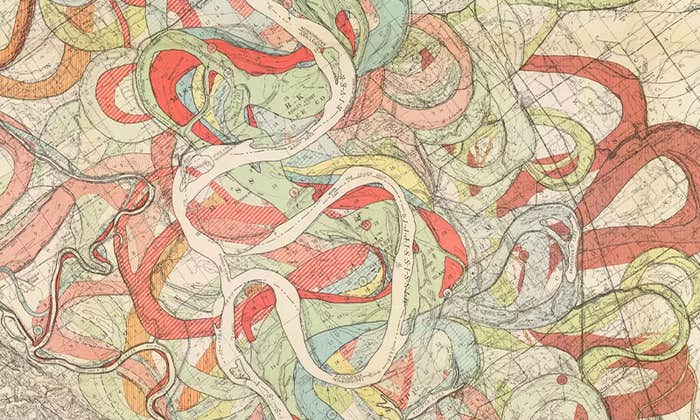Half a lifetime ago, in 1979, I traveled with my college roommate to one of the wonders of the world, a giant salt lake linking Israel and Jordan called the Dead Sea. We arrived at the nearby Ein Gedi Spa at the foot of the Judean Hills, donned swimsuits, and took a short stroll into an expanse of iridescent blue 10 times saltier than the Atlantic back home. I splayed my arms and legs and bobbed in the sun like a buoy, unsinkable in a legendary pool revered for its healing properties 1,338 feet below sea level, the lowest spot on Earth.
When I returned last November, I was thrilled to find the spa and its restaurant still intact. But instead of sauntering to the shore, I had to take a trolley—a rough and tumble ride across a mile of sand and rocks to a body of water visibly smaller than before. The Dead Sea retained its iridescent blue and buoyancy, but the sense of serenity was gone. The shoreline had moved because the great sea of salt was shrinking. Receding water had left massive stores of solid salt in cavities underground. When fresh water from nearby aquifers rushed in to dissolve that salt, it left in its wake thousands of underground voids. These subterranean craters—called sinkholes— can suddenly collapse under the slightest pressure or weight, swallowing people, houses, and roads. Some experts predict the Dead Sea will be no more than a puddle by 2055.
For more than 100 years, Israeli planners have dreamed of merging the low-lying Dead Sea with a higher-altitude sea, either the Mediterranean Sea or the Red Sea, to generate hydroelectric power as water tumbled down. In recent years, a merger with the Red Sea has been seen as a means of refilling the Dead Sea to healthy levels of yore.
But as plans take shape to engineer a conduit, some scientists who have studied the Dead Sea for the past decade say the merger may not help but harm the sea. In November, looking out over the azure water, Michael Lazar, a marine geologist at the University of Haifa, questioned the very idea of “saving” the ancient sea. Water levels have risen and fallen with changing climate over eons of geologic time, he explained. Given the natural cycles, he wondered out loud, “What does saving the Dead Sea really mean?”

For those in the region, the Dead Sea taps powerful cultural and religious beliefs; it has been a sacred destination for pilgrims since ancient times. Even today, the integrity of its shore sustains a tourist industry selling the Dead Sea mystique. But the impetus to save the sea is fraught: Those lamenting its loss are consuming the thing they love. Unlike past contractions, climate change today accounts for a small percent of the Dead Sea’s decline. The major culprit now is rapacious water use. Jordan and Israel (along with Lebanon and Syria) have relentlessly tapped the Jordan River, the Dead Sea’s main tributary, for drinking and irrigation, accounting for two thirds of the annual water loss. And two companies, Arab Potash in Jordan and Dead Sea Works in Israel, plumb the Sea for its minerals, guzzling water.
Given regional hostilities, the merger was no more than a pipe dream until 1994, when Israel and Jordan signed a treaty to develop their shared border—including the shrinking Dead Sea. The centerpiece of that plan was an engineering colossus: an $800 million pipeline transporting water 110 miles across the region and 1,000 feet downhill.
Stopping the Dead Sea’s decline was just part of the benefit. The project included a hydroelectric plant to generate power at the mouth of the Dead Sea, where it would be used to desalinate half the water coming through. The result would be 900 million cubic meters a year of potable water for Israel, thirsty Jordan, and the Palestinian Territory—and another 900 million cubic meters to stabilize the Dead Sea shore. It was a “Peace Conduit,” leaders said, a project with practical value that would foster cooperation and goodwill.
There were plenty of objections. Critics said red algae from the Red Sea could float on top of the Dead Sea, heating up in the sun and proliferating to a massive, toxic red tide that might turn the Dead Sea the color of dried blood. They worried that mixing the chemicals in the two waters would create gypsum, a mineral made of calcium, sulfur, oxygen, and water, turning the Dead Sea milky white. And what if the massive pipes leaked as they passed through what is, after all, an earthquake zone between the two seas? Gushing saltwater could pollute fresh groundwater stores used for drinking and farming, already in short supply.
The water level has been far lower than now—and has always come back. So what does saving the Dead Sea really mean?
To help settle the debate, the Israelis, the Jordanians, and the Palestinian Authority asked the World Bank to study the risks. That $16.5 million study, completed in January 2013, found the massive project would indeed threaten groundwater and could turn the Dead Sea red or white. Another impediment, notes Alexander McPhail, the World Bank water specialist who oversaw the investigation, was cost. The energy generated by the downhill flow would be sufficient to desalinate the water for drinking—but not enough to pay for pumping that drinking water back uphill to the Jordanian capital of Amman, where it was needed most. Sending the water on to Amman would require construction of two additional power plants. The cost of the project would soar to at least $10 billion, more than 10 times what was originally thought.
Responding to those reports, the three governments signed a modified plan in December 2013. The first part involves a water swap: A desalination plant would be built at the Gulf of Aqaba, located at the Northern tip of the Red Sea by the coast of Jordan and Israel. That plant would extract more than 80 million cubic meters of potable water a year, dividing it between the cities of Aqaba in Jordan and Eilat in Israel. In exchange, Israel would sell water from its giant freshwater lake, the Sea of Galilee, to Jordan’s capital city of Amman in the North and the Palestinians in the West. “Building the pipeline will enhance political stability and have an overall positive effect on the peace process as these countries work together,” said McPhail.
So far, so good. But the revised plan also includes a Red Sea-Dead Sea conduit for transporting 80 million cubic meters of briny water (leftover from Red Sea desalination) to the Dead Sea in the north. Filtered slowly into the Dead Sea, this modest infusion of brine shouldn’t lead to milk-of-gypsum waters or red tides, the World Bank contends, and could be used to test the waters for more transfers up the road.
Yet even the scaled-down pipeline makes environmentalists see red. “One drop is too much,” says Amman-based Munqeth Mehyar, chairperson and Jordanian director of Friends of the Earth Middle East. His criticism stems in part from Dead Sea life forms discovered so recently that World Bank studies couldn’t take them into account.
As far back as the 1990s, scientists knew the Dead Sea was engaged in another, hidden merger: infusion of freshwater springs arriving from outside Jerusalem and entering beneath the salt lake bed. Despite these springs, most experts presumed the salt lake, with its unwavering blue surface and high levels of magnesium, calcium, and phosphorous, was devoid of all but the sparsest microbial life. Then in 2009, Danny Ionescu, a marine microbiologist at the Max Planck Institute for Marine Microbiology in Germany, was tasked with sampling the underwater springs, some of which run longer than 100 meters and up to 20 meters deep. Following the trail the springs cut through the lake, Ionescu and team found “life screaming at us—an entirely new microbial ecosystem in the Dead Sea.”
At a Tel Aviv café on the Mediterranean, Ionescu described his Dead Sea work. To defy the lake’s buoyancy, he lined his wetsuit with almost 90 pounds of extra weight before his descent. First, he saw “salt crystals sink through the water column like snow.” Deeper still, literal pillars of salt, “like Lot’s wife.” Ionescu descended until a sinkhole without visible margins came into view. “Sliding along the wall, meter after meter, it felt like traveling through time,” he recalled. At the bottom of that black hole, he saw white and green biofilms carpeting rocks and sand around numerous small, freshwater springs. This was just the start. That first sinkhole led to another, fed by more underwater springs containing more life, “until the bottom of the Dead Sea bent down in a steep slope heading for the lake’s abyss at 300 meters depth.”

Ionescu had discovered what would be the first of many sinkhole strings, each fed by underwater springs and coated with species of microbial life never before described. “The organisms come from the Dead Sea sediments, not from the springs. The springs are the source of nourishment,” Ionescu explained. Though extensive studies have yet to be done, Ionescu has already identified new species of green sulfur bacteria, cyanobacteria, and diatoms within the green biofilm. Among the unique metabolic properties of the newfound species is the ability to cope with extreme changes in salinity caused by fluctuation of the springs.
The consequences of adding Red Sea water to the rare balance of minerals sustaining these Dead Sea life forms remains unknown, but one could be blooms of the strange new microbes at the lake’s surface; like red algae, the newly found organisms could change the color of the sea, robbing it of its enchanting blue tint and hurting tourism.
“It depends on how diluted the Dead Sea water becomes,” Ionescu noted. “The spring water shoots to the surface because it is lighter than the Dead Sea water and carries bacteria along for the ride. If the water is diluted enough, these organisms may do quite well at the surface.” Indeed, you wouldn’t need to dilute the Dead Sea to change the color at the surface; all you would need is a thin layer of lighter, lower salinity Red Sea water, “like a spoonful of oil floating on top of a bowl of water,” Ionescu explained. The apparent color of the Dead Sea could be altered by that top layer, no matter what was happening underneath.
He and others also hypothesize that the canal could increase the sinkhole phenomenon. One worry is that as more diluted water, with lower levels of salt, penetrated sediments on the Dead Sea shores, stores of salt would be more prone to dissolve and be absorbed into nearby aquifers and streams. Ionescu has found that “sulfur bacteria in water flowing down from the mountain aquifers can accelerate sinkhole formation.” This suggests that any increase in such organisms within the Dead Sea would need to be studied for impact on the sinkholes as well.
“These are some of the most primitive life forms on the planet and may hold the key to understanding how life arose on Earth.”
Lazar, the University of Haifa marine geologist, suspects the Dead Sea may not be as endangered as some contend. In his first job on the lake, as early as 1999, he led a survey of the sea floor from his mobile headquarters, a yellow submarine. Since then, his team has drilled cores of earth from the Dead Sea going back to the Pleistocene in hopes of charting a history of climate change through the last 10,000 years. The warmer the climate, the lower the water level and the less new sediment, he explained. Sequestered lakes like the Dead Sea are perfect places for such exploration because, without water and sediments flowing out, the record is preserved. “What happens in Vegas stays in Vegas,” Lazar said.
Using a series of drill bits at the deepest part of the Dead Sea and also near the Ein Gedi shore, Lazar and colleagues pulled out two continuous cores from hundreds of feet below the surface of the lake bed. While the data is still being analyzed and results are coming in, one finding is clear: The Dead Sea was subject to drastic climate changes in the past. “It was once much lower than today,” Lazar said. Yet over the centuries, natural processes prevented the sea from drying up. “At some point, an equilibrium will be reached between natural evaporation and what little water enters the lake through groundwater springs, rain, and runoff,” he adds. “So I don’t know what people mean when they talk about saving the Dead Sea.”
Today, with water being siphoned off the Jordan River to quench a thirsty region, and with mineral companies pumping water out of the Dead Sea, nature appears to be losing the battle with man. Even so, Lazar finds the proposed merger with the Red Sea “problematic in many ways.”
“Just turning on the tap and re-flooding the Dead Sea does not seem like a very smart idea,” he offered. Further, the merger could interfere with research. “There is a very unique ecosystem of micro-bacteria and fungi that manages to thrive in the extreme environment of the hyper-saline waters,” he said. “These are some of the most primitive life forms on the planet and may hold the key to understanding how life arose on Earth.”
Along with Mehyar of Friends of the Earth, Lazar maintained that rehabilitation of the Jordan River held the key to conservation. “I think that the best way to conserve the Dead Sea would be to reintroduce the natural flow from the Jordan River and decrease the pumping of water from the lake to the factories,” he said. Mehyar wants the companies to pay a water fee to rein them in. New technologies, he added, could enhance water recycling and help ensure the region has enough to drink without having to create the destructive conduit. But with powerful political and cultural currents behind the recent plan to merge the seas, it remains to be seen whether the view from the science labs will carry much weight in the ancient debate over saving the Dead Sea.
Pamela Weintraub is the psychology editor at Aeon magazine and a freelance writer based in Brooklyn.























